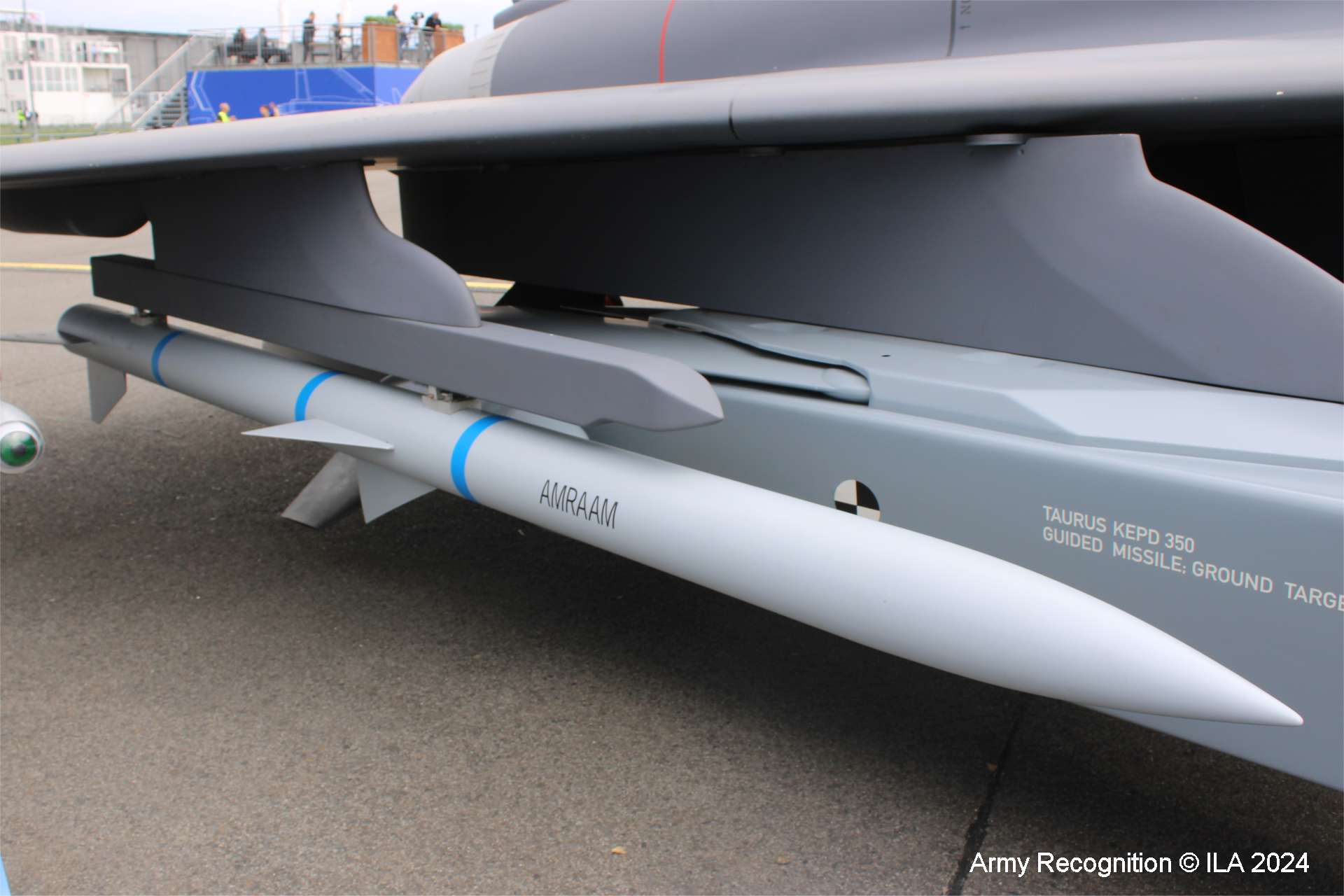US Approves Sale of Advanced AIM-120C-8 Air-to-Air Missiles to Singapore

{loadposition bannertop}
{loadposition sidebarpub}
On September 9, 2024, the U.S. State Department approved a potential Foreign Military Sale to the Government of Singapore, including the delivery of advanced AIM-120C-8 air-to-air missiles and associated equipment. This sale, estimated at $133 million, was notified to Congress by the Defense Security Cooperation Agency (DSCA).Follow Army Recognition on Google News at this link
RTX AIM-120C-8 Air-to-Air Missile (Picture source: Army Recognition)
In this request, Singapore sought the purchase of fifty-four AIM-120C-8 missiles, an advanced version of the medium-range air-to-air missile (AMRAAM), along with two additional AMRAAM guidance sections. The sale also includes various unclassified equipment and services, such as spare control sections, missile containers, testing equipment, and technical and logistical support services provided by the U.S. government and its contractors.
The primary contractor for this deal would be RTX Corporation, based in Tucson, Arizona.
The AIM-120C-8 AMRAAM is designed for all-weather, beyond-visual-range aerial combat and is compatible with various U.S. Air Force and Navy aircraft such as the F-15, F-16, F-22, and F/A-18. It features a sophisticated guidance system combining active radar terminal guidance with inertial mid-course navigation, enabling pilots to engage multiple targets simultaneously and perform evasive maneuvers. The AIM-120C-8, an improved version of the AIM-120C series, stands out with its extended range and enhanced resistance to electronic jamming, thanks to upgrades in its guidance system and sensors. Its range, estimated at over 100 kilometers, allows it to engage targets before they pose a threat to the launching aircraft. Introduced in 1991, this missile variant is a continuation of the AIM-7 Sparrow series but offers significant enhancements in speed, size, and target engagement capabilities.
This sale is seen as key support for U.S. foreign policy and national security objectives, aiming to strengthen the position of a strategic ally in Asia. As a stabilizing force in the Indo-Pacific region, Singapore already benefits from close military relations with the U.S., particularly in terms of interoperability with U.S. and allied forces.
According to the Military Balance 2023, Singapore has an operational fleet of 105 combat aircraft. Among them are 100 multirole fighters, including 40 F-15SG Eagles, 20 F-16C Block 52 Fighting Falcons, 20 F-16D Block 52 Fighting Falcons, and 20 F-16D Block 52+ Fighting Falcons, including reserve aircraft. These aircraft are equipped to fire the advanced AIM-120C-8 AMRAAM, thereby enhancing their air defense capabilities and ability to engage medium-range targets.
The State Department emphasized that this agreement would not only improve Singapore’s operational capabilities but also help maintain regional stability in light of growing tensions in this strategic area. The introduction of these missiles will increase the effectiveness of the Singapore Armed Forces (SAF) in both training and combat operations, thus reinforcing deterrence in this key region.
The Singapore Armed Forces are considered the best-equipped in Southeast Asia. Their structure is largely modeled after the Israeli system, with the air force and navy primarily composed of professional personnel, while the much larger army relies mainly on conscripts and reservists, aside from a small core of career soldiers.
The modernization of the SAF’s equipment continues, with a boost given by the “SAF 2040” vision, launched in March 2022. This plan outlines acquisition and modernization priorities across all domains, including the creation of a fourth branch of the armed forces, the Digital and Intelligence Service, which was established in October 2022.
Key acquisition projects include F-35 fighter jets, multi-role combat vessels, unmanned surface vessels, unmanned aerial vehicles, offshore patrol vessels, maritime patrol aircraft, and various land equipment. These efforts aim to maintain Singapore’s military edge over other Southeast Asian countries.

{loadposition bannertop}
{loadposition sidebarpub}
On September 9, 2024, the U.S. State Department approved a potential Foreign Military Sale to the Government of Singapore, including the delivery of advanced AIM-120C-8 air-to-air missiles and associated equipment. This sale, estimated at $133 million, was notified to Congress by the Defense Security Cooperation Agency (DSCA).
RTX AIM-120C-8 Air-to-Air Missile (Picture source: Army Recognition)
In this request, Singapore sought the purchase of fifty-four AIM-120C-8 missiles, an advanced version of the medium-range air-to-air missile (AMRAAM), along with two additional AMRAAM guidance sections. The sale also includes various unclassified equipment and services, such as spare control sections, missile containers, testing equipment, and technical and logistical support services provided by the U.S. government and its contractors.
The primary contractor for this deal would be RTX Corporation, based in Tucson, Arizona.
The AIM-120C-8 AMRAAM is designed for all-weather, beyond-visual-range aerial combat and is compatible with various U.S. Air Force and Navy aircraft such as the F-15, F-16, F-22, and F/A-18. It features a sophisticated guidance system combining active radar terminal guidance with inertial mid-course navigation, enabling pilots to engage multiple targets simultaneously and perform evasive maneuvers. The AIM-120C-8, an improved version of the AIM-120C series, stands out with its extended range and enhanced resistance to electronic jamming, thanks to upgrades in its guidance system and sensors. Its range, estimated at over 100 kilometers, allows it to engage targets before they pose a threat to the launching aircraft. Introduced in 1991, this missile variant is a continuation of the AIM-7 Sparrow series but offers significant enhancements in speed, size, and target engagement capabilities.
This sale is seen as key support for U.S. foreign policy and national security objectives, aiming to strengthen the position of a strategic ally in Asia. As a stabilizing force in the Indo-Pacific region, Singapore already benefits from close military relations with the U.S., particularly in terms of interoperability with U.S. and allied forces.
According to the Military Balance 2023, Singapore has an operational fleet of 105 combat aircraft. Among them are 100 multirole fighters, including 40 F-15SG Eagles, 20 F-16C Block 52 Fighting Falcons, 20 F-16D Block 52 Fighting Falcons, and 20 F-16D Block 52+ Fighting Falcons, including reserve aircraft. These aircraft are equipped to fire the advanced AIM-120C-8 AMRAAM, thereby enhancing their air defense capabilities and ability to engage medium-range targets.
The State Department emphasized that this agreement would not only improve Singapore’s operational capabilities but also help maintain regional stability in light of growing tensions in this strategic area. The introduction of these missiles will increase the effectiveness of the Singapore Armed Forces (SAF) in both training and combat operations, thus reinforcing deterrence in this key region.
The Singapore Armed Forces are considered the best-equipped in Southeast Asia. Their structure is largely modeled after the Israeli system, with the air force and navy primarily composed of professional personnel, while the much larger army relies mainly on conscripts and reservists, aside from a small core of career soldiers.
The modernization of the SAF’s equipment continues, with a boost given by the “SAF 2040” vision, launched in March 2022. This plan outlines acquisition and modernization priorities across all domains, including the creation of a fourth branch of the armed forces, the Digital and Intelligence Service, which was established in October 2022.
Key acquisition projects include F-35 fighter jets, multi-role combat vessels, unmanned surface vessels, unmanned aerial vehicles, offshore patrol vessels, maritime patrol aircraft, and various land equipment. These efforts aim to maintain Singapore’s military edge over other Southeast Asian countries.





